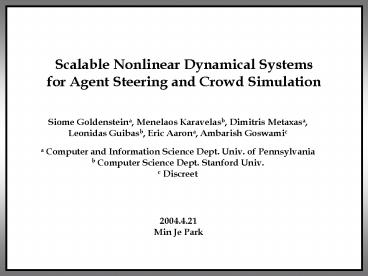Scalable Nonlinear Dynamical Systems - PowerPoint PPT Presentation
1 / 41
Title:
Scalable Nonlinear Dynamical Systems
Description:
hybrid systems. Global Environment Control. How to keep environmental information up-to-data ... Hybrid Dynamical Systems : continuous discrete dynamics 'Go ... – PowerPoint PPT presentation
Number of Views:45
Avg rating:3.0/5.0
Title: Scalable Nonlinear Dynamical Systems
1
Scalable Nonlinear Dynamical Systems for Agent
Steering and Crowd Simulation
Siome Goldensteina, Menelaos Karavelasb, Dimitris
Metaxasa, Leonidas Guibasb, Eric Aarona, Ambarish
Goswamic a Computer and Information Science
Dept. Univ. of Pennsylvania b Computer Science
Dept. Stanford Univ. c Discreet
2004.4.21 Min Je Park
2
Outline
- Introduction
- Overview
- Background
- Local System
- Global Environment Control
- Global Planning Layer
- Experiments
- Conclusions and Future Work
3
Introduction
- Modeling low-level behavior (scalable and
efficient)
4
Overview
- A novel 3-layer framework
Environmental
Local
Global
- local basic reactive actions - environmental
knowledge about agents immediate environment -
global general knowledge about the environment
5
Overview
- How to model ?
kinetic data structure (KDS)
nonlinear dynamical system
Environmental
Local
Global
potential field hybrid systems
6
Background
Dynamical system
Linear dynamical system (superposition principle)
Nonlinear dynamical system (hard to analyze,
chaotic?)
7
Background
Critical points (or fixed points)
zero-crossings of f - a critical
point is a stationary point for the system -
local analysis about the critical points
8
Background
An Example
9
Background
Kinetic data structure (KDS)
a system with objects moving at vastly varying
speed
- Evaluating at each time step ?? - Exploiting
the continuity of motion and temporal coherence
10
Background
Kinetic data structure (KDS)
Proof near points Certificates simple atomic
relationships (such as
distance comparisons)
11
Background
Kinetic data structure (KDS)
12
Overview
kinetic data structure (KDS)
nonlinear dynamical system
Environmental
Local
Global
potential field hybrid systems
13
Local System
Modeling the low-level movement of every
agent What is the agent ? - heading angle -
forward velocity - some personality attributes
14
Local System
Agent heading angle
f a nonlinear function env the state of the
environment
Design objective - avoiding an obstacle
(repeller) - pursuing a target (attractor)
Observation - repellers and attractors are
located at the critical points
15
Local System
Agent heading angle
Positive any slight change will deviate farther
away with time
(repeller) Negative inverse situation
(attractor)
16
Local System
Configuration revisited
17
Local System
Attractor function
18
Local System
Repeller function
collide !!!
Spatial extent, distance
19
Local System
Repeller function
20
Local System
Repeller function
21
Local System
How to combine?
? artifacts !!!
22
Local System
How to combine?
Nonlinear constraint competition dynamical system
4 critical points
23
Local System
Designing choices Goldenstein2001 Stability
analysis Perko1991
24
Local System
Forward velocity
rmin the distance to the closet obstacle d1
Safety distance t2c time to contact
25
Local System
Personality - angular acceleration (moment of
inertia) - forward acceleration (mass) -
aggressiveness (subjective quantity)
26
Local System
Extension to three dimensions
27
Overview
kinetic data structure (KDS)
nonlinear dynamical system
Environmental
Local
Global
potential field hybrid systems
28
Global Environment Control
How to keep environmental information up-to-data
as the agents move and the environment changes
Proof points inside a certain circle
Cx Certificates Delaunay triangularion
- containing a lot of proximity information -
easy to maintain as the points move continuously
(edge-flip operations). A
certain set of edges crossed by Cx
29
Global Environment Control
30
Global Environment Control
Advantages - conservative estimates for the
failure of the KDS certificates can be computed
using motion estimates provided by the local
system - O(nn) ? O(n)
31
Overview
kinetic data structure (KDS)
nonlinear dynamical system
Environmental
Local
Global
potential field hybrid systems
32
Global Planning Layer
Global minima vs. Local minima
Pacman is trapped !!!
33
Global Planning Layer
Objective giving each agent the general
direction How? Precomputed velocity fields
- can be given by the designer
- can be generated by harmonic functions
(potential fields)
34
Global Planning Layer
Harmonic functions (solutions to the Laplace
equation)
Ideal fluids (Incompressible and non-viscous)
35
Global Planning Layer
Boundary conditions - targets potential -
obstacles potential (including the
configuration space boundary) Properties -
no local minima (no curl, no chaos) - global
minima at the targets potential
36
Global Planning Layer
Implementation
37
Global Planning Layer
Hybrid Dynamical Systems continuous
discrete dynamics Go in the direction of
the target Ignore the target for now Just
escaping this apparent local minima
38
Experimental Result
A simple crowd simulation
A moving obstacle
39
Experimental Result
A friendly target
A hostile obstacle
40
Experimental Result
A hybrid system
41
Conclusions
A novel three-layered system - agent steering -
customizable behavior - real-time environment
changes Technical novelty - nonlinear dynamical
systems - KDS - hybrid systems (global planning
layer)































